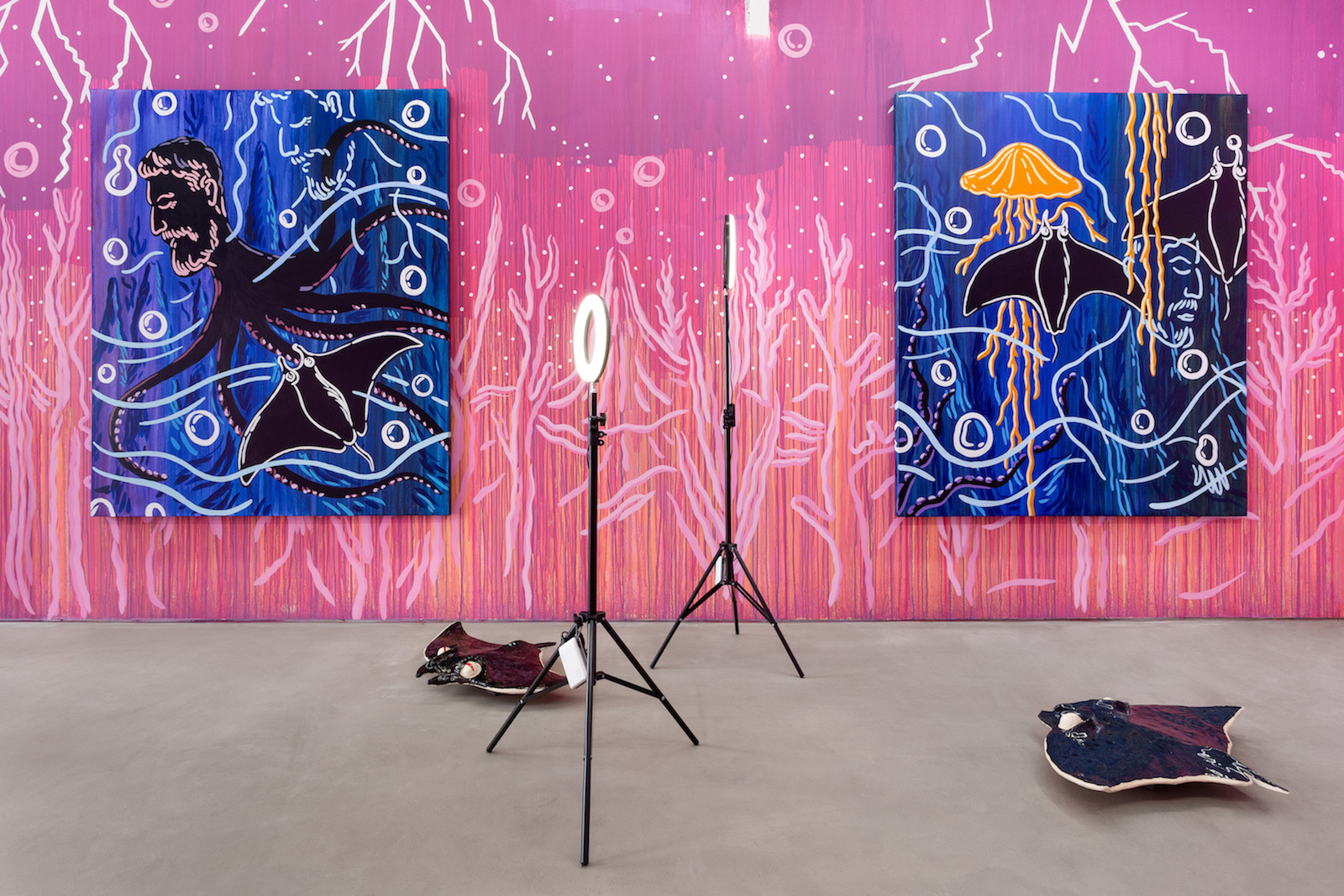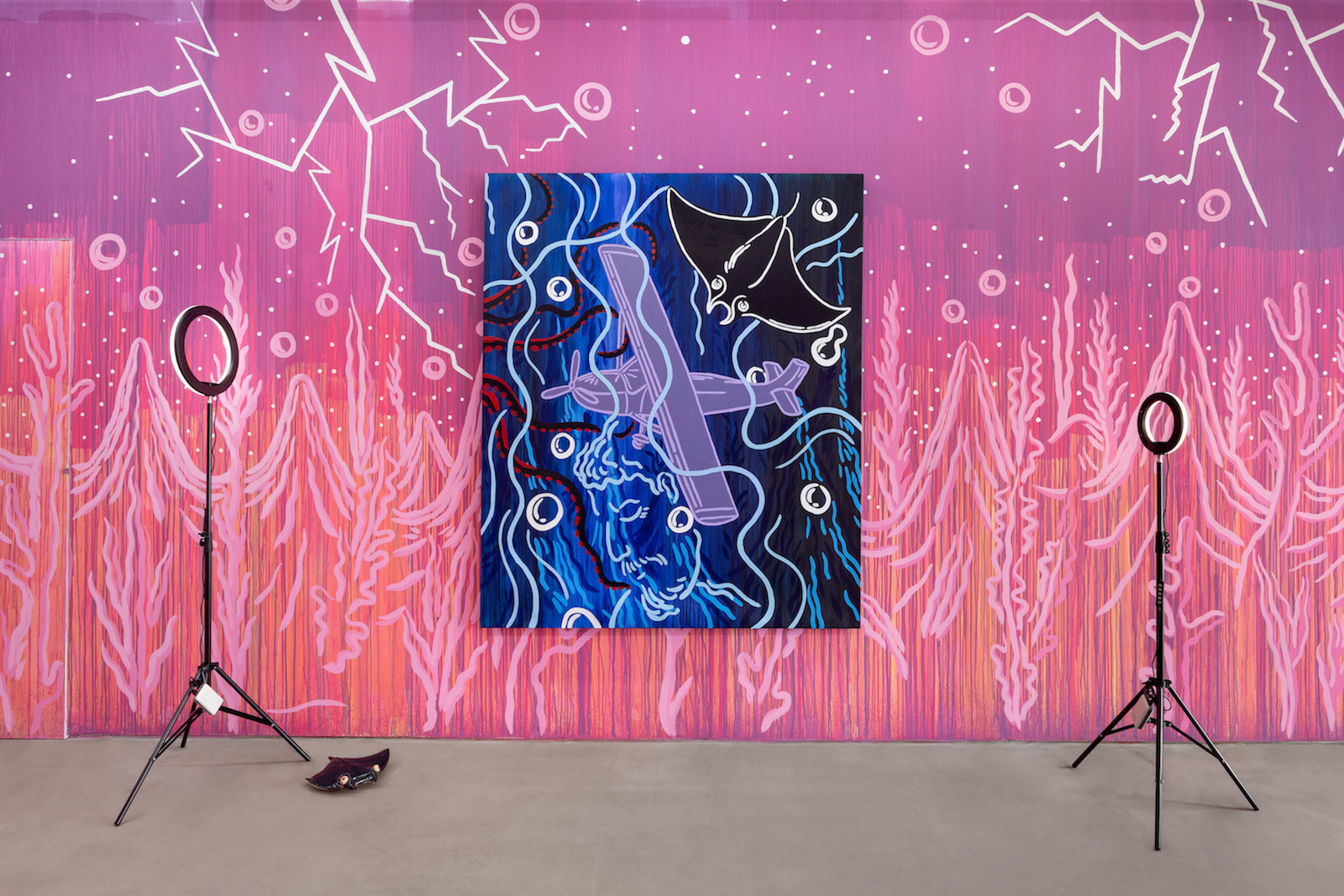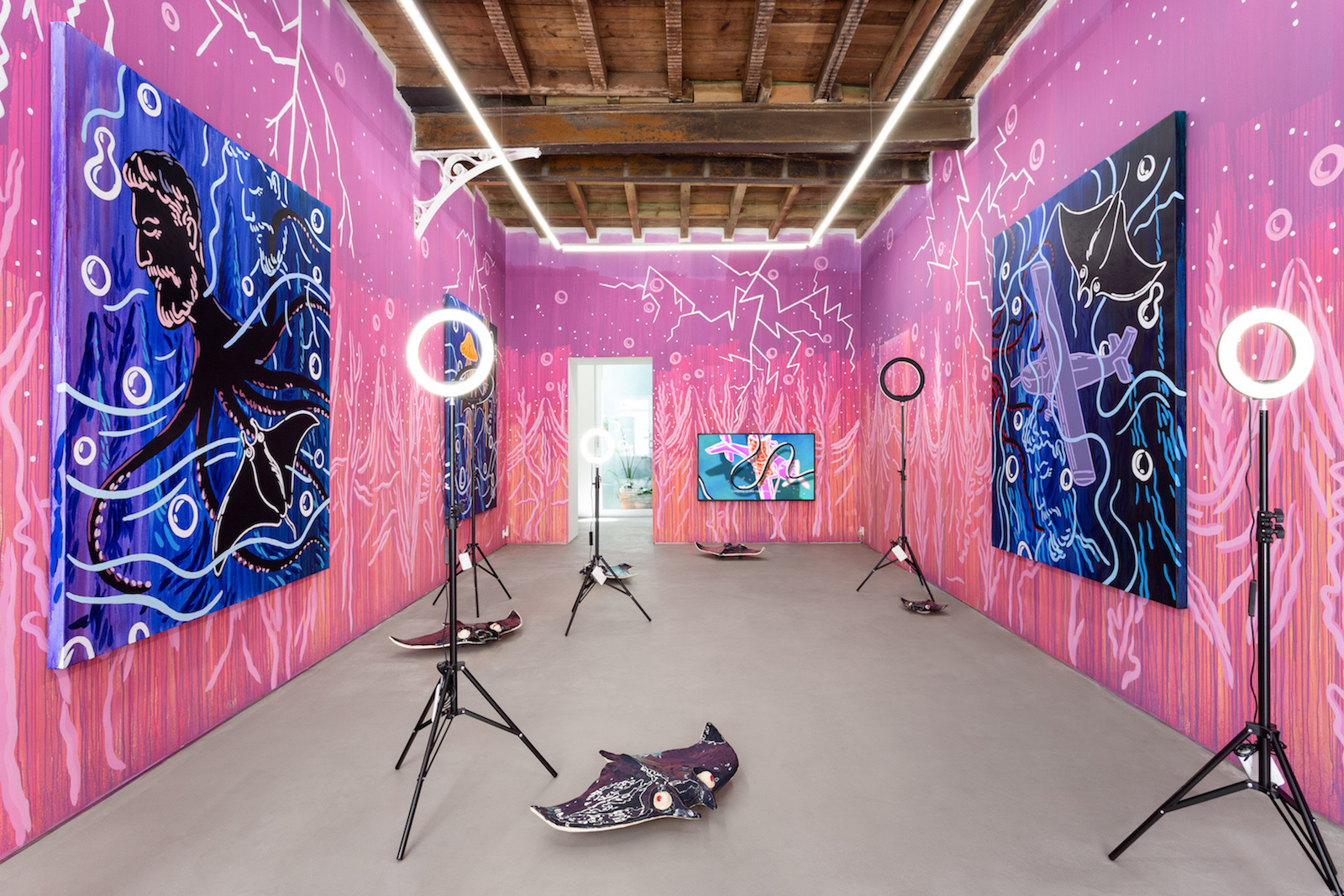Luís Lázaro Matos: Seabed Monsters and the Cosmic Rays

Manta Rays Celestial Ballet
In Seabed Monsters and the Cosmic Rays, Luís Lázaro Matos's third solo exhibition at Madragoa, the artist proposes an exciting immersive universe that is both cosmic and submarine. The walls of the small gallery space are hand-painted with rose-coloured rising aquatic plants, the colour of which is reminiscent of glow-in-the-dark bacteria and sea creatures, who are met from above by threatening white nets of lightning. Water and electricity are a dangerous mix, but apparently Matos was inspired by the theory that during the early days of Earth’s genesis, lightning strikes freed phosphorus into the water—an essential chemical for the formation of biomolecules and the development of planetary life—which started life’s process on Earth. A good place to start.
A series of blue-toned large paintings, Seabed Monsters and the Cosmic Rays 1—3 (all works 2021) represent scenes from an imagined deep sea. Here, the head of a bearded man, whose lines could be that of a Roman-Greek statue is depicted in a therianthropic way with a tentaculate body. He is swimming in the depths of the ocean next to a manta ray and they are both surrounded by air bubbles (or ring lights) and wavy lines. There, two manta rays are swimming upwards and they are accompanied by an orange mushroom-like jellyfish. In the background, in delicate pale blue lines are the contours whose likeness reminds us of the bearded character—the exhibition’s very own Poseidon—and whose torso is standing straight as if he were upright on the ocean floor. In the third painting, a manta ray crosses over the canvas’s surface representing a deep undulating ocean, and is looking down on a propeller biplane—who might be in the ocean or just reflected by its polished waters. In physics, fluid dynamics is a field of study that defines fluids as either liquid or gas to describe their particular flow through space. Matos comic-like drawings naturally embrace these laws of physics, showing that some travels through air and water answer to the same gravity laws, and could merge together as if in the same environment.
A catchy original 80s-pop-rock-style soundtrack accompanies Matos’s visual fusion of deep-space and deep-sea sceneries. It’s the artist’s song "Bermuda Triangle", with accompanying vocals by artist Diana Policarpo, that is playing on a screen in the gallery’s back wall with its anime video clip. The song comes from Matos’s third album, Waves and Whirlpools (the artist started recording music in recent years) and its dreamy repetitive beats and melody bring out the show’s gliding and floating ingredients to the forefront. The bright-coloured animation features concentric swirls of manta rays, guitar-playing whales, pufferfishes, the now familiar bearded man sleeping on his belly on a surf board or cosied up under a blanket atop a propeller biplane. Other recognisable elements, such as drawn wave lines and ring light bubbles whirl crescendo towards the centre of the screen as if they were being engulfed by some kind of vortex, rhythmically resonating with the exhibition’s celestial-subaquatic narratives. The lyrics are just as puzzling as the visual contents of the clip, and describe lights that take the boats away and friends-stealing flying saucers—a captivating emotional poem.
On the floor, several deep-blue, nearly black, manta rays, deftly made in ceramics, tragicomically look up with exaggerated eyeballs towards the social media ring lights standing next to them. Their irises are red, perhaps because of the sleepless nights they have spent creating content in confinement, alienated from their peers, and their painted surfaces are satisfyingly shiny. In space, cosmic rays are energy particles that move at nearly the speed of light. They originate from either inside or outside our solar system and it’s enough to think about it to feel the wonderful idea of an expanded universe which motion we can only perceive as much slower than it really is. Manta rays could be seen as flying in the waters like energy waves, unhurriedly flapping their wings to glide forward with celestial grace. In this show, the prevalence of rays is overall a soothing phenomenon, yet at the same time they carry a slight touch of anxiety and dizziness—magnified by the artificiality of the social media lights and the swirling in the video—that keeps us on our toes.
Overall, once the blow of the immersion in strong graphic colours subsides, the exhibition’s elegant undulating lines that frame the universe of these beautifully executed drawn or ceramic manta rays are very inviting. Together, all the elements offer an alluring incursion into a whimsical world of oceanic wonders, where gravity is replaced by fantasy with a pinch of psychedelics. A pink, blue, and bright vortex of comic-like wrinkles through time, space, and water that vibrate in par with the deepest theories about our universe balances agitation and calm in the most fanciful fashion.
Cristina Sanchez-Kozyreva is an art critic, curator and writer. She is a regular international contributor to art publications such as Artforum, Frieze, Hyperallergic, and other publications including the South China Morning Post. She was the co-founder and editor-in-chief of Hong Kong-based independent art magazine Pipeline that ran print editions form 2011 to 2016 where she curated thematic issues with artists, curators and other art contributors. She has a Masters degree in International Prospective from Paris V University.
Proofreading: Diogo Montenegro.


Luís Lázaro Matos: Seabed Monsters and the Cosmic Rays. Exhibition views Madragoa Gallery. Photos: Bruno Lopes. Courtesy of the artist and Madragoa Gallery.
